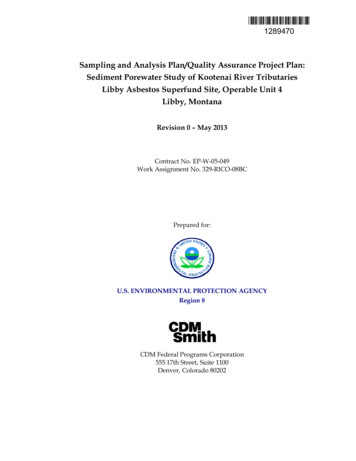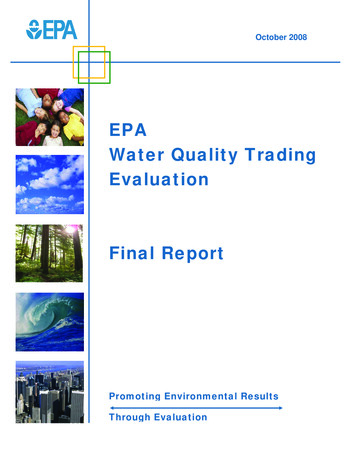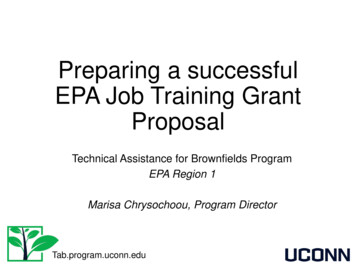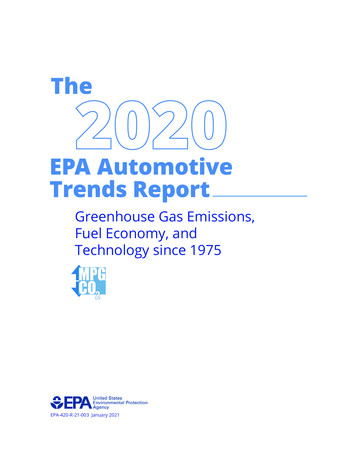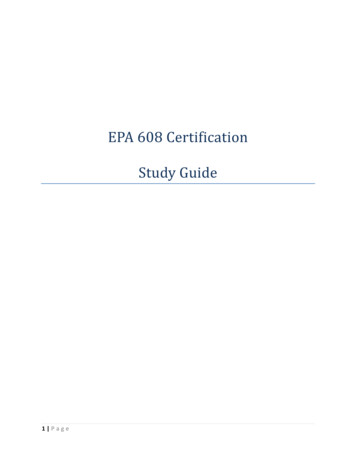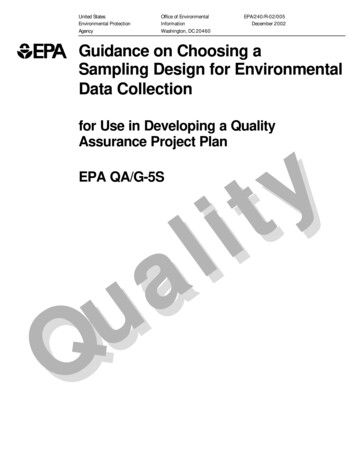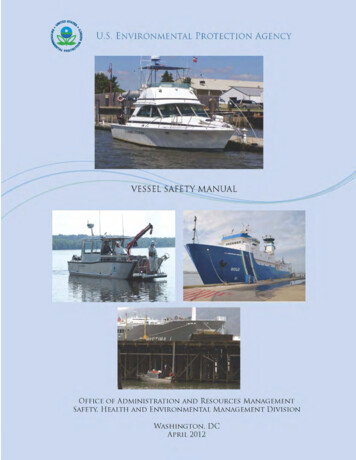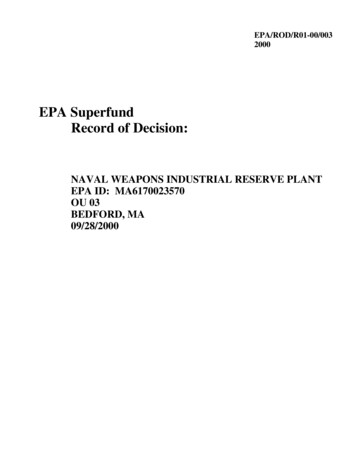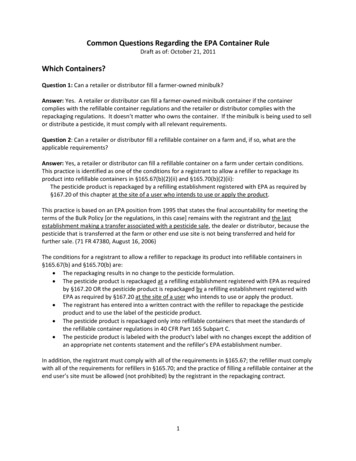
Transcription
Common Questions Regarding the EPA Container RuleDraft as of: October 21, 2011Which Containers?Question 1: Can a retailer or distributor fill a farmer-owned minibulk?Answer: Yes. A retailer or distributor can fill a farmer-owned minibulk container if the containercomplies with the refillable container regulations and the retailer or distributor complies with therepackaging regulations. It doesn’t matter who owns the container. If the minibulk is being used to sellor distribute a pesticide, it must comply with all relevant requirements.Question 2: Can a retailer or distributor fill a refillable container on a farm and, if so, what are theapplicable requirements?Answer: Yes, a retailer or distributor can fill a refillable container on a farm under certain conditions.This practice is identified as one of the conditions for a registrant to allow a refiller to repackage itsproduct into refillable containers in §165.67(b)(2)(ii) and §165.70(b)(2)(ii):The pesticide product is repackaged by a refilling establishment registered with EPA as required by§167.20 of this chapter at the site of a user who intends to use or apply the product.This practice is based on an EPA position from 1995 that states the final accountability for meeting theterms of the Bulk Policy [or the regulations, in this case] remains with the registrant and the lastestablishment making a transfer associated with a pesticide sale, the dealer or distributor, because thepesticide that is transferred at the farm or other end use site is not being transferred and held forfurther sale. (71 FR 47380, August 16, 2006)The conditions for a registrant to allow a refiller to repackage its product into refillable containers in§165.67(b) and §165.70(b) are: The repackaging results in no change to the pesticide formulation. The pesticide product is repackaged at a refilling establishment registered with EPA as requiredby §167.20 OR the pesticide product is repackaged by a refilling establishment registered withEPA as required by §167.20 at the site of a user who intends to use or apply the product. The registrant has entered into a written contract with the refiller to repackage the pesticideproduct and to use the label of the pesticide product. The pesticide product is repackaged only into refillable containers that meet the standards ofthe refillable container regulations in 40 CFR Part 165 Subpart C. The pesticide product is labeled with the product's label with no changes except the addition ofan appropriate net contents statement and the refiller’s EPA establishment number.In addition, the registrant must comply with all of the requirements in §165.67; the refiller must complywith all of the requirements for refillers in §165.70; and the practice of filling a refillable container at theend user’s site must be allowed (not prohibited) by the registrant in the repackaging contract.1
Sub-question 2(a): In this situation, what standards would the refillable container at the farm have tomeet?Answer to Sub-question 2(a): As stated above, the pesticide must be repackaged only into refillablecontainers that meet the standards of the refillable container requirements in 40 CFR Part 165 SubpartC. [§165.67(b)(4) and §165.70(b)(4)] Regardless of whether the container is portable or stationary, therefillable container must be properly labeled with the refiller’s EPA Establishment Number and netcontents filled in. The applicable refillable container requirements are described below.Portable refillable containers must be identified on the registrant’s description of acceptable containersfor that pesticide [§165.70(e)(3)] and meet the relevant requirements in 40 CFR Part 165 Subpart C. Thismeans that the portable refillable container must: Comply with the DOT requirements that are adopted in §165.45(a) or §165.45(b);Be durably marked with a serial number or other identifying code [§165.45(d)]; andHave a one-way valve or a tamper-evident device or both on any opening that is not a vent if thecontainer is designed to hold liquids and is not a DOT-compliant cylinder [§165.45(e)].Stationary refillable containers must be identified on the registrant’s description of acceptablecontainers for that pesticide [§165.70(e)(3)] and must be durably marked with a serial number or otheridentifying code [§165.45(d)]. The other requirements in 40 CFR Part 165 Subpart C do not applybecause the requirements apply only to portable containers [§165.45(a), (b) & (e)] or to stationarycontainers at the location of a refiller operating under contract to a registrant [§165.45(f)].Sub-question 2(b): In this situation, would the repackaging have to be done on a containment structure?Answer to Sub-question 2(b): It depends on where the repackaging takes place. EPA has authorized 21states1 to continue implementing their state pesticide containment regulations in lieu of the federalcontainment regulations. In these 21 states, the state pesticide containment regulations may requireon-farm transfers to be conducted on a containment pad and for containers above a certain size to be insecondary containment structures. The federal containment regulations, which apply in the other 29states and in Indian country, do not require containment for on-farm transfers. The preamble to the2006 final rule stated:“As described in the preamble to the proposed rule, EPA decided to require containment structures atdealers, commercial applicators and custom blenders with bulk storage tanks, largely because thesewere the kinds of sites where contamination had been documented. EPA did not and still does not havedocumentation of end user site contamination due to repackaging pesticide product. Therefore, thefinal pesticide container and containment regulations do not require repackaging at end user sites to bedone within a containment structure. However, EPA strongly recommends that repackaging at end usersites be conducted over some kind of containment--whether it is a permanent concrete containmentpad or a portable containment structure.” [71 FR 47380-47381, August 16, 2006]Question 3: Do minibulks that retailers use only for their own commercial application purposes have tocomply with the new regulations?1The 21 states are Colorado, Florida, Illinois, Indiana, Iowa, Kansas, Kentucky, Louisiana, Michigan, Minnesota,Missouri, Montana, Nebraska, New Hampshire, North Dakota, Ohio, South Dakota, Vermont, Washington, WestVirginia and Wisconsin.2
Answer: If an applicator transfers a pesticide into a container for the purposes of that applicatorapplying the pesticide, the container is considered to be a "service container." A service container isdefined as "any container used to hold, store, or transport a pesticide concentrate or a pesticide usedilution mixture, other than the original labeled container in which the product was distributed or sold,the measuring device, or the application device." Service containers are not subject to any of thepesticide container and containment regulations.As discussed in the preamble of the 2006 final container and containment rule (71 FR 47383, August 16,2006 - see the attachment), EPA does not currently regulate service containers although we do believethat it is a good management practice to ensure that the contents of service containers are identifiedand that the label of a pesticide product that is in a service container is available to the person handlingand/or applying the pesticide. The purpose of identifying the contents of the service container is toassure that adequate information regarding the pesticide can be obtained in case of medical orenvironmental emergency. While there are no current regulations or policies about the informationthat should be included on the container to identify the pesticide, in the past, EPA has recommendedthat the following information be securely attached to a service container holding pesticide concentrate: The name, address and telephone number of the pest control firm; [if applicable] Product name; EPA Registration number; Name and percentage of active ingredients; and Signal word from the label.Question 4: A refiller (retailer or distributor) repackages into a compliant minibulk container accordingto all required procedures and labeling and drives the container out to a grower location where thecontainer is pumped into a container used by the grower to transport product into the field. Is thisallowable under the container regulations? The delivery container is properly labeled and managed justas though it was to be sold outright.Answer: Whether the farmer’s container is a service container or a portable refillable container dependson who pumps the pesticide from the compliant portable refillable container into the farmer’scontainer. If the repackaging facility pumps the pesticide into the farmer’s container, then the farmer’scontainer is a portable refillable container that is being used to sell or distribute the pesticide and wouldhave to comply with the requirements in the regulations, as described in question 2 above aboutwhether containers can be filled at an end user site. However, if the repackaging facility delivers thecompliant portable refillable container to the farmer and the farmer pumps the pesticide into hiscontainer, then it would meet the criterion for a service container, which is “if an applicator transfers apesticide into a container for the purposes of that applicator applying the pesticide.” See question 3above for more details about service containers.DOT RequirementsQuestion 5: When does a refillable pesticide container that is marked with the UN symbol need to beleakproofness tested?Answer: It depends on the size of the container and whether the pesticide is a DOT hazardous material.3
For refillable pesticide containers that are UN-marked and have capacities greater than 119 gallons(called intermediate bulk containers or IBCs), the leakproofness test and external inspection must beconducted every 2.5 years and an internal inspection must be conducted every 5 years. [49 CFR180.352] This is true regardless of whether the pesticide is or is not a DOT hazardous material.For refillable pesticide containers that are UN-marked and have capacities of 119 gallons or less(nonbulk) that hold pesticides that are DOT hazardous materials, the containers must beleakproofness tested before each reuse [49 CFR 173.28(b)(2)] unless the conditions in 49 CFR173.28(b)(7) are met. The refillable container must be inspected before each reuse [49 CFR173.28(a)].For refillable pesticide containers that are UN-marked and have capacities of 119 gallons or less(nonbulk) that hold pesticides that are not DOT hazardous materials, the EPA refillable containerregulations exempt refillers from the requirement in 49 CFR 173.28(b)(2) to conduct theleakproofness test before each reuse if the container complies with the refillable containerregulations and the refilling is done in compliance with the repackaging regulations (including avisual inspection before each reuse). [40 CFR 165.45(a)(2)] The refillable container must beinspected before each reuse [49 CFR 173.28(a) and 40 CFR 165.65(e) or 165.70(f)].Question 6: In addition to the leakproofness testing itself, what other activities are required by DOT’scontinued qualification requirements for refillable pesticide containers that are greater than 119 gallonsand marked with the UN symbol?For full details, please see the attached document “Retest and Inspection Requirements forIntermediate Bulk Containers.” Refillable pesticide containers that are greater than 119 gallons, markedwith the UN symbol, and are metal, rigid plastic or composite IBCs2 “may not be filled and offered fortransportation or transported until the test or inspection has been successfully completed. Thisparagraph does not apply to any IBC filled prior to the test or inspection due date.” [49 CFR 180.352(a)]The required tests and inspections are: The IBC must be tested according to the leakproofness test prior to its first use in transportationand every 2.5 years thereafter, starting from the date of manufacturer or the date of a “major”repair (as described in §180.352(d)(1)).An external visual inspection must be conducted initially after production and every 2.5 yearsstarting from the date of manufacture or the date of a “major” repair.The IBC must be internally inspected at least every five years.Also, the date (month and year) of the most recent leakproofness test and internal or externalinspection must be marked on the IBC in a place near the UN symbol, as described in 49 CFR 178.703(b),and records of the leakproofness test and inspections must be kept [49 CFR 180.352(g)]. See theattached document for more details.Question 7: Can a retailer conduct the leakproofness test (required every 2.5 years)?Answer: Yes, a retailer (or anyone) can conduct the leakproofness test and the required DOT inspectionsif he/she: follows the procedure in the DOT regulations, marks the container and keeps the requiredrecords. See questions 5 and 6 for more details. In addition, people who do the testing or marking are2Composite IBCs are commonly called caged tanks.4
hazmat employees3 according to the DOT regulations and therefore must meet the DOT trainingrequirements in 49 CFR 173.1 (general) and 172.704 (specific).Question 8: How does a retailer become DOT hazmat trained?According to 49 CFR 172.702(c): "Training may be provided by the hazmat employer or other public orprivate sources." DOT's web site has a lot of information about the required training and trainingmodules. For more information, see:- General Hazardous Materials web site: http://www.phmsa.dot.gov/hazmat- Training and Outreach: http://www.phmsa.dot.gov/hazmat/training-outreach- Training Requirements: nts- Training Modules: ons/modulesMONSANTO TANKS (NON-DOT MARKED TANKS)Question 9: Why do Monsanto’s 120-, 150- and 250-gallon Shuttle containers and 265-gallon CUBEcontainers comply with EPA’s refillable container regulations even though they do not have the DOT/UNmarking?Short answer: Monsanto’s 120-, 150- and 250-gallon Shuttle containers and 265-gallon CUBE containerscan be used under EPA’s refillable container regulations even though they do not have the DOT/UNmarking because they are “non-DOT Specification portable tanks suitable for the transport of liquids.”The U.S. Department of Transportation (DOT) regulations in 49 CFR 173.241(c), which are incorporatedinto EPA’s refillable container regulations, authorize the use of non-DOT Specification portable tankssuitable for the transport of certain low-hazard liquids.Details: For pesticides that are not DOT hazardous materials and are sold or distributed in refillablecontainers, EPA’s regulations in 40 CFR 165.45(a)(1) require the pesticide to be packaged in a refillablecontainer that, if portable, is designed, constructed, and marked to comply with certain requirements inDOT’s regulations at a Packing Group III level. This section in EPA’s regulations refers to and adopts asubset of DOT’s Hazardous Materials Regulations (HMR), including 49 CFR 173.241(c), which states:“DOT Specification 51, 56, 57 and 60 portable tanks; IMO type 1, 2 and 5, and IM 101 and IM 102portable tanks; UN portable tanks; marine portable tanks conforming to 46 CFR part 64; and nonDOT Specification portable tanks suitable for transport of liquids are authorized. ” (Emphasisadded,)The DOT regulations authorize the use of these types of containers, including non-DOT Specificationportable tanks4 5 suitable for transport of liquids, for certain DOT hazardous materials that are low3The definition of hazmat employee includes "an individual, employed on a full time, part time or temporary basisby a hazmat employer, or who is self employed, who during the course of employment.designs, manufactures,fabricates, inspects, marks, maintains, reconditions, repairs, or tests a package, container or packaging componentthat is represented, marked, certified, or sold as qualified for use in transporting hazardous materials incommerce." (49 CFR 171.8)4EPA believes that Monsanto’s 120-, 150- and 250-gallon Shuttles and 265-gallon CUBEs are “non-DOTSpecification portable tanks” based on DOT Interpretation 10-0186. This interpretation states “An IBC is definedby the HMR as a rigid or flexible portable packaging, other than a cylinder or specification portable tank, that isdesigned for mechanical handling (see § 171.8).” The DOT interpretation further states that “If the specification5
hazard liquid and solid materials. By citing 49 CFR 173.241(c) in the refillable pesticide containerregulations, EPA is allowing non-DOT Specification portable tanks suitable for transport of liquids to beused to distribute or sell pesticides that are not DOT hazardous materials. (See the Table of HazardousMaterials and Special Provisions in 49 CFR 172.101 to determine the packaging that DOT authorizes forpesticides that are hazardous materials.)Please note that Monsanto has not received a specific exemption or waiver from EPA for its Shuttles andCUBEs, which are bulk packagings6. Instead, for refillable pesticide containers larger than 119 gallons,Monsanto is choosing to use containers that are authorized by 49 CFR 173.241(c) rather than by 49 CFR173.241(d), which is also incorporated into EPA’s regulations. Section 173.241(d) authorizes the use ofintermediate bulk containers (IBCs) that comply with the DOT testing requirements for IBCs at thePacking Group III performance level.The option for “non-DOT Specification portable tanks suitable for transport of liquids” is not valid forrefillable containers that are 119 gallons or smaller (for liquid pesticides that are not DOT hazardousmaterials). These smaller containers are UN marked non-bulk packagings7. Section §165.45(a)(1) inEPA’s regulations refers to and adopts 49 CFR 173.203, which lists the authorized non-bulk packagingsfor liquid hazardous materials in Packing Group III. All of the non-bulk containers identified in 49 CFR173.203 must be designed, tested and marked to comply with DOT’s requirements at the Packing GroupIII performance level. Therefore, all refillable pesticide containers that are 119 gallons or smaller mustbe designed, tested and marked to comply with DOT’s requirements at the Packing Group IIIperformance level.Question 10: Do Monsanto’s 120-, 150- and 250-gallon Shuttle containers and 265-gallon CUBEcontainers (that do not have the DOT/UN marking) need to be leakproofness tested every 2.5 years? Dothese Shuttle containers and CUBEs need to pass the DOT external inspection every 2.5 years or the DOTinternal inspection every 5 years?No, Monsanto’s 120-, 150- and 250-gallon Shuttle containers do not need to be leakproofness tested orDOT inspected according to the requirements in 49 CFR 180.352 (which is referred to and adopted byEPA’s refillable pesticide container regulations.) Monsanto’s Shuttle containers and CUBE containers are“non DOT-Specification portable tanks” rather than IBCs and the “requirements for retest and inspectionof IBCs” in 49 CFR 180.352 only apply to IBCs “constructed in accordance with a UN standard.”markings [on an IBC] are destroyed, removed, or covered, the packaging no longer meets the standards of aspecification packaging in accordance with the HMR. Therefore the packaging is a non-specification bulk packagingand can be considered a non-specification portable tank.” (Letter from T. Glenn Foster, U.S. DOT to Erin N. Jarman,URS Corporation)5Section 173.241 of DOT’s regulations require non-DOT Specification portable tanks suitable for transport ofliquids to comply with the “general packaging” requirements in 49 CFR Part 173 for DOT hazardous materials,including §173.24 “General requirements for packagings and packages”; §173.24b “Additional generalrequirements for bulk packagings” and §173.32 “Requirements for the use of portable tanks.” For pesticides thatare not DOT hazardous materials, EPA’s regulations refer to and adopt 49 CFR 173.24 and 173.24b, but not 49 CFR173.32. Therefore, non-DOT Specification portable tanks suitable for transport of liquids that are used forpesticides that are not DOT hazardous materials must comply with 49 CFR 173.24 and 173.24b.6DOT defines “bulk packaging” as “a packaging, other than a vessel or a barge, including a transport vehicle orfreight container, in which hazardous materials are loaded with no intermediate form of containment. Additionally, a bulk packaging has: (1) A maximum capacity greater than 450 L (119 gallons) as a receptacle for aliquid; ” (49 CFR 171.8)7“Non-bulk packaging means a packaging which has: (1) A maximum capacity of 450 L (119 gallons) or less as areceptacle for a liquid; ” (49 CFR 171.8)6
Specifically, 49 CFR 180.352(a) states: “Each IBC constructed in accordance with a UN standard for whicha test or inspection specified in paragraphs (b)(1), (b)(2) and (b)(3) of this section is required may not befilled and offered for transportation or transported until the test or inspection has been successfullycompleted.” Section 180.352(b) establishes test and inspection requirements for metal, rigid plastic andcomposite IBCs. Monsanto’s 120-, 150- and 250-gallon Shuttle containers and 265-gallon CUBEcontainers are not IBCs so the retest and inspection requirements in 49 CFR 180.352 do not apply tothem.Refillable pesticide containers need to be leakproofness tested if the DOT regulations that are referredto and adopted into the pesticide container regulations require the testing. There are no EPA-specificrequirements in the pesticide container regulations that require pesticide containers to beleakproofness tested. However, EPA’s repackaging regulations do require a refiller to inspect acontainer each time before it is refilled. (40 CFR 165.65(e) and 165.70(f))Currently, Monsanto is considering a revision to their repackaging contracts to require refillers toconduct a periodic performance test of some type on Monsanto 120-, 150- and 250-gallon Shuttles and265-gallon CUBEs to address the continued qualification of these containers.RepackagingQuestion 11: Is the description of acceptable containers required to be in the repackaging agreement?No, a description of the acceptable containers is not required to be included the repackaging contract.Instead, the repackaging regulations require a registrant to develop a written description of acceptablecontainers and provide it to a refiller before or at the same time as the pesticide is distributed or sold tothe refiller. Registrants can choose to include the description of acceptable containers in therepackaging contract, and many registrants do this. (40 CFR 165.65(c)(1) & (d)(5) and 165.67(f)(1) & (g)).Question 12: Are 15-gallon minibulks the smallest size that can be refilled? Can a 2 1/2 gallon containerbe refilled?There are no size limits in the regulations for refillable containers. (40 CFR 165.70(e)(4)) Therefore, a2.5-gallon container could be refilled as long as it met all of the applicable regulations, including but notlimited to: (1) being identified as a refillable container on the pesticide label; (2) complying with therequirements for portable refillable containers in 40 CFR 165.45; (3) being included on the registrant’sdescription of acceptable containers for the pesticide; and (4) being refilled according to therequirements in the repackaging regulations, 40 CFR 165.60 – 165.170.Question 13: If I repackage from one size minibulk to another do I need to follow all the regs or do theyapply only when you repackage out of bulk?Yes, if you repackage from a minibulk, you need to meet the requirements set forth in 40 CFR Part 165.Transferring pesticide from one minibulk tank to another is considered repackaging and must be done incompliance with the five conditions in 40 CFR 165.67(b) and 165.70(b) which include entering into awritten contract with the registrant. In addition, the registrant must allow the pesticide to betransferred from one minibulk tank to another in the repackaging contract. As the refiller, you mustcomply with the repackaging regulations and the minibulk tanks that are refilled must comply with therefillable container requirements.7
REFILLABLE CONTAINERSQuestion 14: Are nonrefillable 30-gallon drums that come with tamper proof covers on openings goodonly for one use or can they be equipped with a one-way valve and secured with tamper-evident cables?A nonrefillable container can be used only once for sale or distribution, regardless of whether it has oneway valves or tamper evident devices on its openings.The labels of one-way 30-gallon drums are required to have the phrase “Nonrefillable container.” and astatement preventing or severely limiting reuse of the container. By definition, a nonrefillablecontainer can be used only once for sale or distribution. (See 40 CFR 165.3.) The regulations at 40 CFR156.140(a)(2) require one of the following statements after “Nonrefillable container.” on the pesticidelabel on most nonrefillable containers:(i) “Do not reuse or refill this container.”;(ii) “Do not reuse this container to hold materials other than pesticides or dilute pesticides (rinsate).After emptying and cleaning, it may be allowable to temporarily hold rinsate or other pesticide materialsin the container. Contact your state regulatory agency to determine allowable practices in your state.”;or(iii) If the product is ready-to-use and its directions for use allow a different product (similar, butconcentrated formulation) to be poured into the container and diluted by the end user: “Do not reuseor refill this container unless the directions for use allow a different (concentrated) product to be dilutedin the container.”Depending on which of these statements is on the label, it is possible that a nonrefillable drum couldtemporarily hold rinsate if allowed by state regulations, or could be used by the end user to dilute aconcentrated but similar pesticide. Other practices are not allowed. If the label includes the statement“Do not reuse or refill this container.”, the container cannot be reused for any purpose or refilled withpesticide.Pesticides that are exempt from the requirement to have the statements in the first paragraph areplant-incorporated protectants, pesticidal articles, pesticides distributed in transport vehicles, andpesticides in certain inherently nonrefillable containers, such as aerosol cans. (See 40 CFR 156.140(opening paragraph) and 156.140(a)(5), (d) and (e).)Question 15: Can a stationary bulk tank have an external site gauge if it is within the secondarycontainment?External sight gauges are prohibited on stationary liquid containers that are 500 gallons or larger and areat the location of a refiller operating under contract with a registrant regardless of whether thecontainers are in secondary containment. (See 40 CFR § 165.45(f)(2)(ii).) In the 1994 Notice ofProposed Rulemaking, EPA stated that “External sight gauges are vulnerable to damage and could causeall of the contents of a container to be released if they are broken. Therefore, EPA believes it isnecessary to prohibit external sight gauges to ensure the safe use, reuse, and refilling of liquid bulkcontainers. There are other ways to determine the volume of liquid pesticide in a container, includingfloat gauges, calibrations on the side of translucent plastic containers, calibrated dip sticks, andelectronic devices.” (59 FR 6734, February 11, 1994)8
Portable refillable containers must be identified on the registrant's description of acceptable containers for that pesticide [§165.70(e)(3)] and meet the relevant requirements in 40 CFR Part 165 Subpart C. This means that the portable refillable container must: Comply with the DOT requirements that are adopted in §165.45(a) or §165.45(b);


